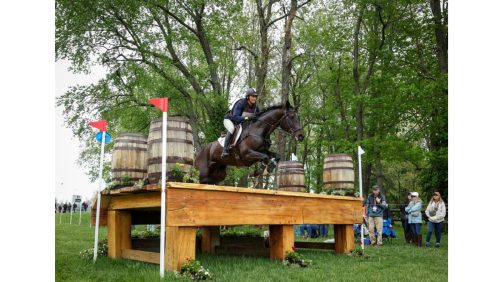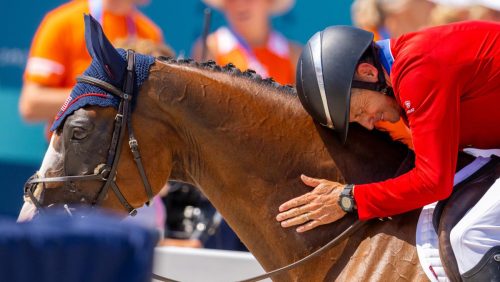Our columnist tries to imagine what eventing will be like when today’s foals reach the peak of their careers.
The horses currently excelling in modern three-day eventing were not “purpose bred” to be good at this sport, because when these top horses were foaled, eventing was altogether different.
When a sport changes radically, and virtually overnight, as eventing has changed, the breeders are caught flatfooted. They have about a 10-year time lag before they can catch up with the new requirements.
Event horse breeders are in a bind, I think, because it’s problematic whether eventing is set and fixed for the foreseeable future, or whether it’s still a sport in flux. Right now upper-level eventing is an unsafe sport, despite the many honest attempts to lessen the dangers. Too many horses are getting injured and killed, as are some of their riders. This state of affairs can’t remain. If the sport isn’t made safer from within, some powers will change it from without, and we don’t know what those changes will be.
This means the event horse breeder is caught in a guessing game. Will the speeds be reduced? Will the cross-country jumps be made easier? Will the show jumping tracks get bigger? Will the dressage tests get more difficult? The point is, we don’t know, so we have to guess. The mare we breed in 2011 won’t have her foal until 2012. That foal will hit its prime at 10 or so, in 2022, and that’s light years from now.
So, here’s my guess, because I don’t think we’ll have 2010 eventing in 2022. Dressage will become more technical and more testing. Show jumping will be higher and more technical. Cross-country speeds at the preliminary, intermediate and advanced levels will be lowered between 10 and 20 meters per minute, and the jumps will be less dangerous, less “daunting.”
So at the advanced level we’ll need very good movers, who are sane enough to let us “get at” that movement.
We’ll need very good jumpers who can get around a 4’3″ to 4’6″ track and leave the rails up. We’ll need horses fast enough and sound enough to gallop somewhere between 550 and 570 meters per minute for 10 to 11 minutes, over fences which are less likely to cause rotational falls than those we have today.
To create these horses, breeders will need to creatively mix the modern Thoroughbred with the modern warmblood and the modern Irish Sport Horse. Thoroughbred blood, now about 75 percent to 90 percent in the average top eventer, will drop to between 50 percent and 75 percent. There will be full Thoroughbreds and horses with very little Thoroughbred blood excelling in 2022 eventing, but the majority will have “a bit of this and a bit of that.”
ADVERTISEMENT
A 2022 pedigree will still have Bold Ruler, Hail To Reason, Native Dancer, Ribot, Mr. Prospector, Northern Dancer, Tom Fool, Seattle Slew and the rest of the usual Thoroughbred suspects. Those Thoroughbreds, as well as such Irish stalwarts as King Of Diamonds, Jumbo and Clover Hill will increasingly be joined by the names of such warmblood jumper line stallions as Cor de la Bryere, Alme, Capitol, Argentinus, Indoctro, Quidam de Revel, Darco, Cassini I, Landgraf and Contender.
I wouldn’t be surprised to see some big name dressage sires creeping into eventing pedigrees either, stallions such as Jazz, Sandro Hit, Donnerhall, and probably someday, Totilas.
If only it were so easy to shake up some of those names in a great blender to produce the eventing star of the future. Let’s have a bit of Alme, a smidgeon of Clover Hill, a dash of Fappiano, a soupçon of Native Dancer. It never works out so easily. It seems always to come down to those rare individuals who can “push” their desired qualities down the genetic chain, the modern day “Justin Morgans” of sport. For the prototypical champion eventer, here are the main qualities the breeders will be trying to produce:
SPEED: Although the speeds and distances may be reduced somewhat, the cross-country phase of eventing will still require a fast horse. The old days of 690 meters per minute on steeplechase are long gone, so the old-fashioned “all day stayer” won’t be needed, but slow, ponderous horses won’t be competitive. Some half-Thoroughbreds are quick and agile and speedy, but some are not. Future eventing will still require the speedy horses.
COURAGE: Courage, also called boldness, has always been a defining character trait of the elite event horse, and although it’s partly derived from systematic training, some of it is inherent. Some horses see something strange and spook. Some spook, then go. The great ones just go. Future eventing will always need courage.
SOUNDNESS: Running and shifting and leaping and landing are all hard on all the systems. Eventing challenges the intrinsic soundness of heart, lungs, bones, tendons, ligaments, muscles and hooves. Some horses are very sound, some not so much. Eventing always has and always will need sound horses.
DRESSAGE: The demands of the dressage phase are already much tougher than 10 years ago, and horses with that lovely floating trot, a light, elegant canter and a quiet enough temperament to be rideable will start out with an enormous advantage. We rarely see horses that placed below the top 15 in dressage standing by the victory podium on Sunday afternoon.
SHOW JUMPING: The show jumping phase will require both scope and that careful desire not to hit the rails, again, a custom-bred warmblood jumper line trait which will need to be incorporated into the genetic mix.
Niche Markets
All the traits and skills I’ve just listed are predicated upon the assumption that the objective is to produce event horses for the top of the sport, which isn’t always the case.
ADVERTISEMENT
Small children like ponies, and many adult amateurs are happiest on very low-key types of horses, and there are eventing breeders who aim to satisfy these two “niche markets.” Ponies are a world unto themselves, and there are any number of competing theories about which breeds or breed crosses produce the best ponies. The most common breeds would include Connemaras and Welshes, and since there are always little people coming along,
I’d imagine the pony world will always thrive.
Draft crosses, mainly Thoroughbreds mixed with Percherons, Belgians, Clydesdales and Irish Draughts, seem to reliably produce that “Steady Eddie, no drama” kind of solid citizen horse needed by so many adults.
Changes at the top of the eventing world shouldn’t affect either the pony breeding market, or the market for the adult amateur.
There are individual mares and stallions that can be counted on to produce one or two of these qualities quite reliably in their foals. The event horse breeder’s enormous challenge is to try to develop breeding stock that can give you most of them all at once.
The more traits you need to breed for, the harder the job becomes. It’s not so hard to get a big chestnut horse.
You breed a big chestnut stallion to a big chestnut mare, and you’re apt to get a big chestnut foal.
Breeding for eventing is doubly daunting. We don’t know what the sport will look like in 10 years, but even if we did, there are just so many traits to breed for.
The best way to simplify this concept is to imagine that instead of using one horse for all three phases, eventing allowed you to ride one horse in each phase. So you’d ride Totilas in dressage, Woodburn on cross-country and Hickstead in the show jumping. The event horse breeder’s job is to create the horse that comes the closest to combining all these qualities in one horse. I’m positive that there are smart, analytical and resourceful breeders out there trying to figure out how to come closer to that hypothetical ideal. I just hope all those breeders don’t speak German!
Denny Emerson rode on the 1974 World Championship gold-medal eventing team. He served as the U.S. Eventing Association president twice and won the USEA Wofford Cup for his lifetime dedication to eventing. At his Tamarack Hill Farm in South Strafford, Vt., and Southern Pines, N.C., he trains horses and riders and stands stallions. An original Between Rounds contributor, Emerson began writing his column in 1989.















